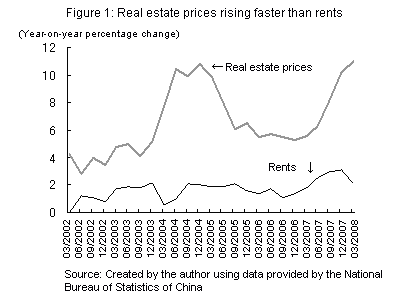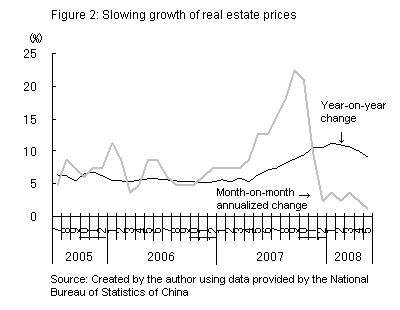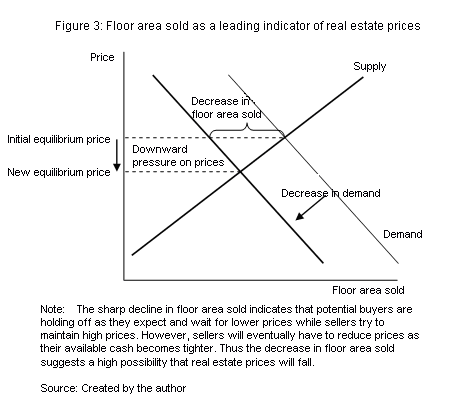The Chinese real estate market, robust until now, is showing increasing signs of moving into an adjustment phase. Underlying factors include: 1) current real estate prices' already being in a bubble state; 2) the government's steps taken to deflate the bubble; 3) the prospects of further monetary tightening to curb inflation; 4) weakened demand for real estate following the Great Sichuan Earthquake on May 12; and 5) sharply falling stock prices.
After rising sharply in recent years, Chinese real estate prices have already reached the bubble stage and will have to go through some adjustments before returning to a level consistent with actual demand. Indeed, real estate prices have been increasing since 2002 at a rate consistently above that of rent increase. This means return on real estate investments, measured in terms of rent income, has kept falling (figure 1). Combined with the fact that interest rates have been rising during the same period, real estate investment profitability is even worse. The expectation of future capital gains has sustained the real estate boom despite the dwindling profitability. However, when real estate prices begin to fall, investors would feel their expectations have been betrayed, which would trigger an exodus of speculative money from the real estate market.
The government has implemented various measures to appease growing public discontent from those who feel their dreams of becoming homeowners are slipping away due to sharply rising in real estate prices. In particular, the Notice of the People's Bank of China and the China Banking Regulatory Commission on Strengthening Management of Commercial Real Estate Credit - announced in September 2007, which, among other things, requires a minimum down payment of 40% as a condition for applying for a mortgage to purchase a second house, has been quite effective in suppressing demand for real estate for investment purposes.
As a part of efforts to address inflation, the People's Bank of China (PBOC, China's central bank) has been tightening its policy. Among various measures taken, interest rate hikes and quantitative restrictions on bank loans have translated into higher financing costs for developers. With stock prices slumping, raising funds through the securities market is becoming more and more difficult. As a result, some developers are forced to sell off their land and real estate, even at reduced prices, to improve their cash flows.
The Sichuan earthquake added downward pressure on the already battered real estate market. Millions of houses collapsed in the earthquake, which reminded people all over the country, not only those living in and around the quake-stricken areas such as Sichuan province and the city of Chongqing, of the importance of housing safety. At the same time, people were awakened to the risk of homeownership, further dampening the demand for homes.
Finally, the sharp fall in stock prices since the autumn of 2007 will likely accelerate the decline of real estate prices. An analysis of housing market trends in the first quarter of 2008, compiled in April by the National Development and Reform Commission, strikes an optimistic tone, as do some researchers, asserting that when stock prices begin to decline, investors would shift their money out of the stock market and into the real estate market, resulting in a further boost in real estate prices. However, as evidenced by Japan's experience since the latter half of the 1980s, stock and real estate prices basically move in tandem. Indeed, China's own experience tells the same; since the latter half of 2005, real estate and stock prices have risen concurrently, boosting each other in an upward spiral. But concerns are now being raised that the recent sharply falling stock prices may turn the upward spiral into a downward one.
Given these circumstances, the real estate market is about to enter an adjustment phase. The index of real estate prices in China's 70 large and mid-sized cities posted a 9.2% year-on-year increase this May, slowing from its peak growth of 11.3% in January. The adjustment trend is more evident in month-on-month comparison; the index for May represents a 0.1% increase (annualized 1.2% growth) from the April level (figure 2). In certain areas, real estate prices are already heading downward. For instance, in Shenzhen, one of the most popular regions for real estate investment, the average selling price of residential properties was 11,014 yuan in May, a sharp 36.5% fall from the peak price of 17,350 yuan in October 2007, according to the Shenzhen Real Estate Research Center. Floor area sold of newly built residential housing in Shenzhen during the first five months of 2008 dropped more than 50% from the same period last year, showing that downward pressure on real estate prices remain strong (figure 3). This trend of decline in floor area sold of residential housing can also be observed in some other major cities.
Riding the recent real estate boom, Chinese banks have significantly expanded mortgages and other real estate-related loans. Sharp falls in real estate prices could turn many of these loans sour, spurring an increase in nonperforming loans. Should this happen, China may have to replicate Japan's experience from the 1990s; banks inevitably stiffen their lending standards and the resulting credit crunch constrains the growth of the whole economy. Also, falling real estate prices, like falling stock prices, could suppress consumption and investment.
Thus movements in real estate prices are vital in foretelling the future course of the economy. Under the influence of the slowdown of the global economy, higher oil prices, monetary tightening, and sharply falling stock prices, the Chinese economy has already entered an adjustment phase. Whether the economy is heading toward a soft or hard landing hinges on how far real estate prices fall.





